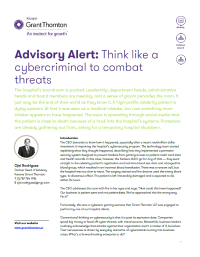-
Financial statements audits
Financial statement audits
-
Compliance audits
Compliance audits
-
Compilations and reviews
Compilations and audit
-
Agreed-upon procedures
Agreed-upon procedures
-
Corporate and business tax
Our trusted teams can prepare corporate tax files and ruling requests, support you with deferrals, accounting procedures and legitimate tax benefits.
-
International tax
Our teams have in-depth knowledge of the relationship between domestic and international tax laws.
-
Tax compliance
Business Tax
-
Individual taxes
Individual taxes
-
Estate and succession planning
Estate and succession planning
-
Global mobility services
Through our global organisation of member firms, we support both companies and individuals, providing insightful solutions to minimise the tax burden for both parties.
-
Sales and use tax and indirect taxes
SUT/ VAT & indirect taxes
-
Tax incentives program
Tax incentives program
-
Transfer Pricing Study
The laws surrounding transfer pricing are becoming ever more complex, as tax affairs of multinational companies are facing scrutiny from media, regulators and the public
-
Business consulting
Our business consulting services can help you improve your operational performance and productivity, adding value throughout your growth life cycle.
-
Forensic and investigative services
At Grant Thornton, we have a wealth of knowledge in forensic services and can support you with issues such as dispute resolution, fraud and insurance claims.
-
Fraud and investigations
The commercial landscape is changing fast. An ever more regulated environment means organizations today must adopt stringent governance and compliance processes. As business has become global, organizations need to adapt to deal with multi-jurisdictional investigations, litigation, and dispute resolution, address the threat of cyber-attack and at the same time protect the organization’s value.
-
Dispute resolutions
Our independent experts are experienced in advising on civil and criminal matters involving contract breaches, partnership disputes, auditor negligence, shareholder disputes and company valuations, disputes for corporates, the public sector and individuals. We act in all forms of dispute resolution, including litigation, arbitration, and mediation.
-
Business risk services
We can help you identify, understand and manage potential risks to safeguard your business and comply with regulatory requirements.
-
Internal audit
We work with our clients to assess their corporate level risk, identify areas of greatest risk and develop appropriate work plans and audit programs to mitigate these risks.
-
Service organization reports
As a service organization, you know how important it is to produce a report for your customers and their auditors that instills confidence and enhances their trust in your services. Grant Thornton Advisory professionals can help you determine which report(s) will satisfy your customers’ needs and provide relevant information to your customers and customers’ auditors that will be a business benefit to you.
-
Transaction advisory services
Transactions are significant events in the life of a business – a successful deal that can have a lasting impact on the future shape of the organizations involved. Because the stakes are high for both buyers and sellers, experience, determination and pragmatism are required to bring deals safely through to conclusion.
-
Mergers and acquisitions
Globalization and company growth ambitions are driving an increase in M&A activity worldwide as businesses look to establish a footprint in countries beyond their own. Even within their own regions, many businesses feel the pressure to acquire in order to establish a strategic presence in new markets, such as those being created by rapid technological innovation.
-
Valuations
We can support you throughout the transaction process – helping achieve the best possible outcome at the point of the transaction and in the longer term.
-
Recovery and reorganization
We provide a wide range of services to recovery and reorganisation professionals, companies and their stakeholders.
The hospital’s boardroom is packed. Leadership, department heads, administrative heads and board members are meeting, and a sense of gloom pervades the room. It just may be the end of their world as they know it. A high-profile celebrity patient is dying upstairs. At first it was seen as a medical mistake, but now something more sinister appears to have happened. The news is spreading through social media that the patient is close to death because of a hack into the hospital’s systems. Protesters are already gathering out front, asking for a temporary hospital shutdown.
Introduction
The CEO demands to know how it happened, especially after a recent multimillion dollar investment in improving the hospital’s cybersecurity program. The technology team started explaining what they thought happened, describing how they implemented a perimeter security system designed to prevent hackers from gaining access to patient credit card data and health records. In this case, however, the hackers didn’t go for any of that — they went straight to the celebrity patient’s registration and real-time blood test data and changed his blood group, which resulted in an incorrect blood transfusion. There was a ransom call, but the hospital was too slow to react. The surgery started and the doctors used the wrong blood type, to disastrous effect. The patient is left irreversibly damaged and is expected to die within 24 hours.
The CEO addresses the room with fire in her eyes and says: “How could this have happened? Our business is patient care and not patient data. We’ve approached this the wrong way. Fix it!”
Fortunately, this was a cyberwar gaming exercise that Grant Thornton LLP was engaged to perform by one of our hospital clients.
Conventional thinking on cybersecurity is that it is past its expiration date. Companies spend big money to head off cyber-threats, with mixed success. Meanwhile, business leaders routinely acknowledge that attacks against their organization aren’t a matter of if, but when. Their nervousness is driven by everyday scenarios of cyberattacks turning into business crises. What’s a forward-looking enterprise to do?
Reaching a higher state — cybersecurity preparedness 2.0 — forces organizations to acknowledge that they live in an evolving environment. Companies must accept that digital innovation is at the heart of business growth. They must recognize that data is an outcome of that innovation. And they must admit that data can also be a liability. Leaders have to be willing to step into the shoes of cybercriminals, understand the potential motivations and threats these bad actors pose and ultimately come up with proactive strategies to protect their organization’s interests.
The journey from reactive to proactive cybersecurity starts by understanding what is important for the business to grow and thrive. The weakest link might be a technology issue plaguing a retail brand. It could be a strategy issue in a life sciences organization. Or it could be a process issue in a financial services enterprise. Regardless of the industry, fostering an understanding of what is truly important for the business is foundational to establishing a sound security strategy.
Treating cyber-risk as separate from other business risks renders it overly technical and mysterious. A more holistic approach to cyber-risk allows companies to place cyber-risks in their proper strategic context and show how management’s acceptance of specific cyberrisks will assist — or fail to assist — in creating value. Businesses that fail to enact a strategic approach, and don’t include all senior managers in defining and meshing their roles in confronting risk, will continue to be stuck at cybersecurity 1.0.
There are a few obvious hallmarks of companies that are relatively immature on the datasecurity spectrum:
Letting fear set the agenda
Cyber-breaches can result in costly losses and embarrassing headlines, but fear of breaches can focus management exclusively on point-specific, IT-centric solutions that are regularly leapfrogged by cybercriminals.
Undervaluing digital assets
Companies often assign values to physical assets, but many fail to grasp the true value of all their data, intellectual property and intangible assets such as brand reputation, executive reputation and customer trust. What’s more, companies frequently fail to assess the full costs of operational, financial and legal risks that stolen data, compromised transactions and corrupted systems can generate.
Doing an unsatisfactory job defining cyber incidents
These include not only external attacks, but also internal breaches, natural disasters and other events that affect systems and data.
Adopting cyber capabilities without enough strategic contexts
Companies often adopt new technologies — such as mobile devices, social media, cloud computing and artificial intelligence — or form new external partnerships, without considering the full array of risks to their business strategies and changes in their risk appetite that these new ventures may introduce.
The emerging universe of risks will run the gamut — some will be technology issues, but others will be business issues or process issues or people issues. But you’ll never know unless everyone is linked to the same effort. Achieving this kind of collaborative approach begins when everyone in a leadership position recognizes the stakes. Getting there requires a few logical steps:
- Own the predicament. Cybersecurity is a top concern of global leaders, as seen in the World Economic Forum’s Global Risks Report 2017. The issue topped the list of most likely risks in North America. For context, consider that more than five million new devices are activated every day. Analysts predict the number of internet of things devices will soar from more than six billion today, to more than 20 billion by 2020. Connectivity equals risk, and therefore everyone is responsible for cybercrime prevention.1
- Map business processes, stakeholders and data systems. Organizations focused on cyber-risk need to adopt the kind of seamless, crash-free and bug-free approach that we see on popular mobile apps — a full-stack view of your assets, consisting of full mapping of business processes, the potential users and related technologies. You need to weigh your cyber-risk by conducting risk assessment of each asset (stack view). Only then is it possible to identify potential risks, consider those risks against risk appetite, and implement controls accordingly. Where risk is elevated, controls need to be higher.
- Align, integrate and measure. It is vital to bring together operational and financial leaders with risk leaders, and align and integrate their goals, objectives, compliance demands, and stakeholder expectations. This will require operational processes to be meshed with cyber controls — with a special focus on where the business is most sensitive. And all this must be overlaid with a system of measurement and metrics, so that leaders always can assess the threat outlook, have options to dial up controls and further enact a digital strategy.
1 “6.4 billion connected ‘things’ will be in use in 2016,” Gartner, Nov. 10, 2015.
Conclusion
The key to managing threats isn’t necessarily greater investment or even manpower. Instead, it takes the imagination of a criminal — seeing your own enterprise as they would see it. Wherever you are most sensitive is the most likely target of future cyber-threats. What is most valuable to you is also most valuable to someone who wants to hurt you.


